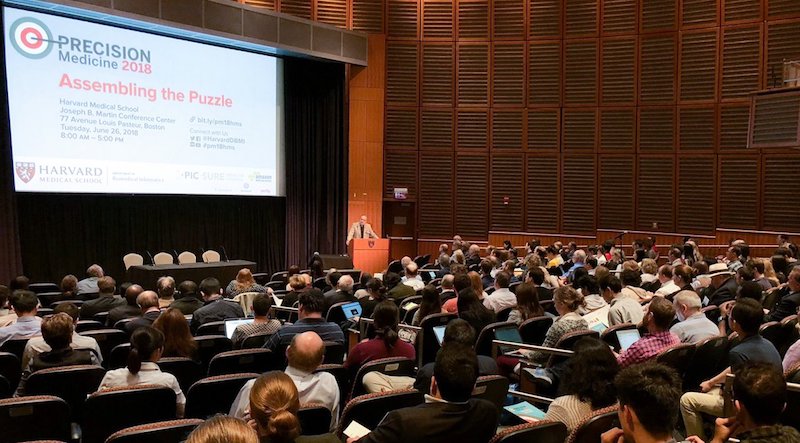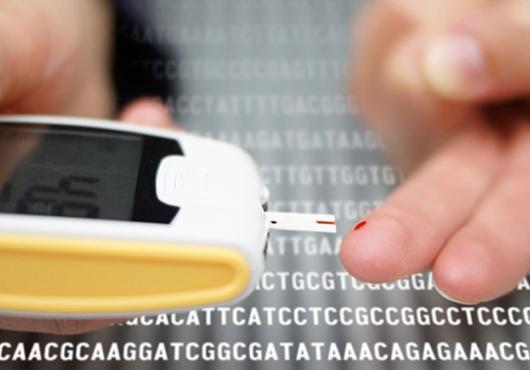
Precision medicine is often equated with high-tech, exquisitely targeted, million dollar drug treatments. But at Precision Medicine 2018, hosted in June by Harvard Medical School’s Department of Biomedical Informatics, many of the speakers and panelists were more concerned about improving health for everyone and making better use of what we already have: data.
“We’re not going to make major changes in 21st century medicine without embracing data-driven approaches,” said HMS Dean George Q. Daley in his opening remarks.
Precision medicine promises the right treatment for the right patient at the right time. But it also has to be at the right price, said Gregory Simon, president of the Biden Cancer Initiative, in his opening keynote.
Medicine has made great advances in cancer therapies, yet “the single biggest determinant of who survives cancer is who has insurance,” Simon said.
Conference organizer Isaac Kohane, head of the Department of Biomedical Informatics, posed the thorny question: “How do you balance a $400,000 tab for helping one individual undergoing precision medicine versus the same tab for helping thousands in Nigeria?”

Farhad Imam, senior program officer at the Bill & Melinda Gates Foundation, noted that in a low-resource setting, solutions often already exist: “For a very poor patient, maybe precision public health begins with clean water.” He also said the foundation is interested in “microbrew biologics”—funding modular platforms that can develop drugs for smaller patient populations, on a shorter cycle and at a lower cost, perhaps $5 million to $10 million.
Simon put forth this idea for improving population health in the U.S.: Treat health as an asset, not a cost. He envisions a futures market where insurance and pharmaceutical companies are incentivized to foster a patient’s lifelong good health.
As an audience member noted, some European health systems already do this. But in the U.S., Simon said, insurance companies say: “I don’t get the financial benefit of saving patients’ lives; they may switch policies,” while drug companies say, “I invested all this money; I need to get paid now.”
“The cost is borne in the beginning; the value is realized in the end,” said Lisa Suennen, senior managing director of GE Ventures, during a later Q&A. “Very expensive drugs with long-term outcomes might have to start in government-funded, single-payer systems.”
Simon also blasted health care systems for not sharing their patient data. “Hospitals are hoarders: Your data is born, lives and dies inside their house,” he said. “If we hoard as individuals, we’re crazy; if you’re an institution, it’s a policy.”
Diagnostic standards vary from institution to institution, making it hard to compare data. The Mayo Clinic and Memorial Sloan Kettering Cancer Center don’t write the same report the same way, said Simon, speaking of his personal experience with leukemia.
Calum MacRae, HMS associate professor of medicine at Brigham and Women’s Hospital, said precision medicine is hamstrung by a so-called phenotype gap.
“To be precise, you need to be comprehensive,” he said. “We are off by several orders of magnitude just in the types of data we collect.” The legacy data we rely on—based on our 9,835 billing codes—is incomplete and often subjective. We need to capture genomic and other -omic information, such as lifestyle and environmental exposure data and day-to-day wellness measures, he said.
For example, MacRae’s team is working with Verily, formerly Google Life Sciences, to build tools to measure cardiometabolic wellness. Paul Varghese, head of health informatics at Verily, aims to collect such information with as little “friction” as possible and serve it up at the point of care to guide decision-making.
Timely data can spur a health system to improve, said Keith Dunleavy, CEO of Inovalon, which provides cloud-based platforms for data-driven health care. His team did a study that identified gaps in care quality for 5,000 New York City patients. It then shared the results with half of the patients’ physicians, and seven months later, 63 percent of the gaps had been resolved. In the control group, where gaps weren’t pointed out, just 3.2 percent were resolved.
The FDA has adopted an increasingly bullish stance, fast-tracking new drugs—some say too quickly—and approving artificial-intelligence-based diagnostics and decision support systems. But providers and the health care systems need to be motivated to adopt new inventions and practices, panelists said. According to MacRae, physicians take up to 12 to 15 years to implement a change, even in the face of evidence. Yet, they continue to use low-sensitivity, low-specificity tests like head CT.
Behavior change isn’t easy, and convincing health care plans, payers and policy makers to change is an even harder battle, speakers agreed.
“Policy makers need to be exposed to the power of the possible,” said Dunleavy.
The talks are available on video.
Adapted from a post on Vector, the Boston Children’s research and clinical innovation blog.
Image: everythingpossible/iStock





